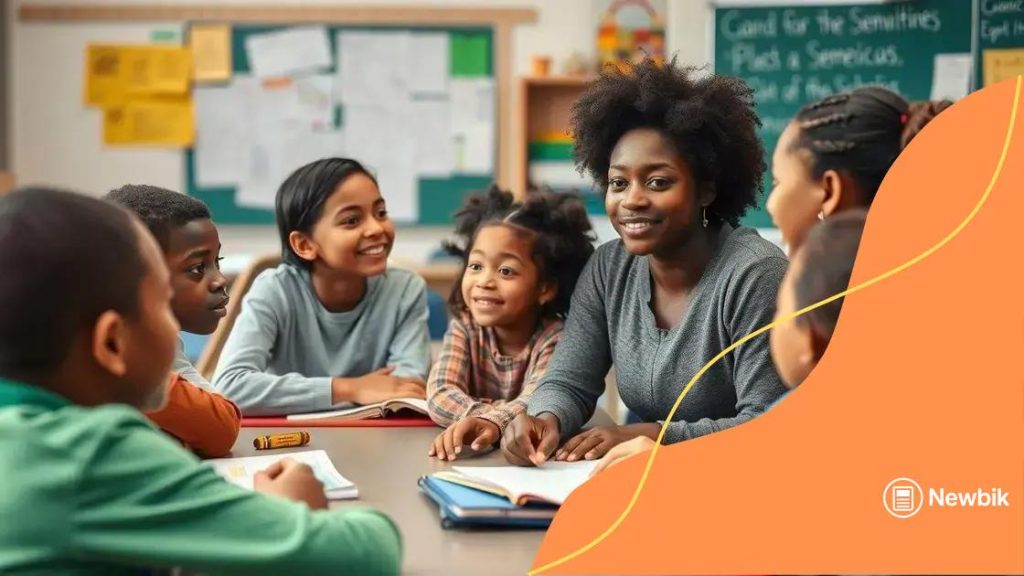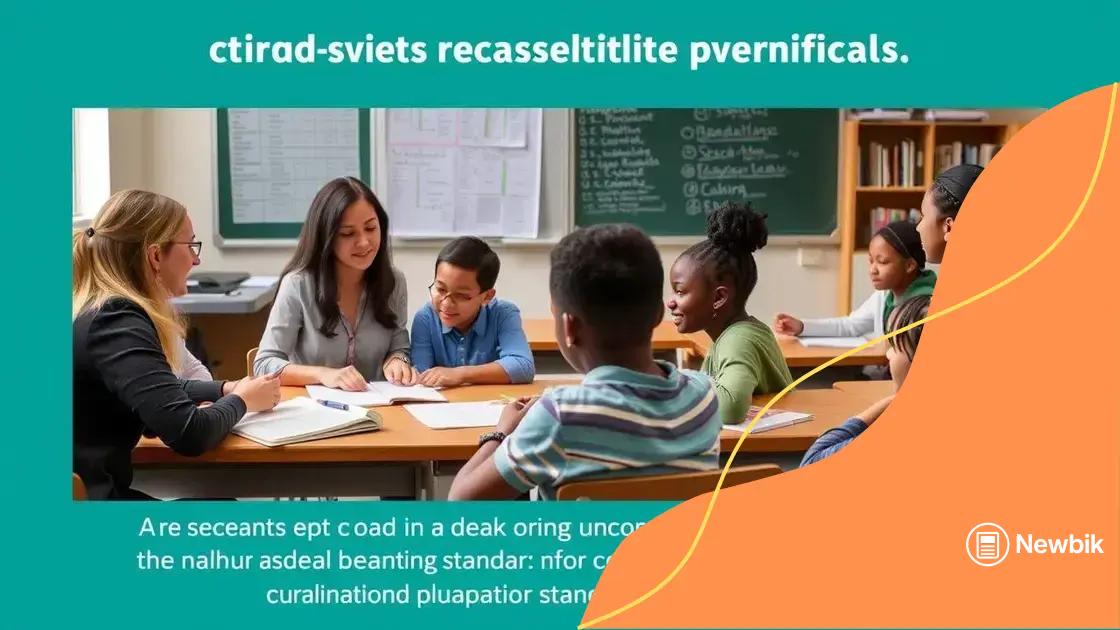K-12 curriculum debates US: what you need to know

K-12 curriculum debates in the US focus on key issues such as technology integration, project-based learning, personalized education, and the essential role of parental involvement, shaping how students engage with their education.
The K-12 curriculum debates in the US are shaping the education system in ways you might not expect. Have you ever wondered how these discussions affect your child’s learning? Let’s dive into the critical topics at hand.
Understanding the K-12 curriculum landscape
Understanding the K-12 curriculum landscape is crucial for parents, educators, and students alike. The curriculum defines what children learn from kindergarten through 12th grade, shaping their knowledge and skills as they grow.
Different states in the US have varying curriculum standards. This can affect everything from the subjects taught to the methods used in classrooms. To comprehend the impact of these differences, it’s important to explore key aspects.
Key Components of the K-12 Curriculum
The K-12 curriculum consists of various components that work together to form a comprehensive educational framework. These include:
- Content Standards: Outlining what students are expected to learn at each grade level.
- Instructional Strategies: Techniques teachers use to engage students and assist their learning.
- Assessment Methods: Tools used to measure student progress and understanding.
Additionally, the curriculum is constantly evolving. Changes may occur in response to new educational research or societal needs. Consequently, schools may adopt new materials and reformulate their teaching approaches to stay current.
The Role of State Education Boards
State education boards play a significant role in determining K-12 curriculum standards. They establish guidelines to ensure students across the state receive a quality education. This process can lead to variations in how subjects are taught. For example, science education may emphasize environmental studies in one state but focus on technical skills in another.
Moreover, as discussions around educational equity grow, many states are revising their curricular standards to be more inclusive. This shift aims to represent diverse perspectives and backgrounds within the educational material.
Challenges in the K-12 Curriculum
While there are many advancements in K-12 education, challenges still exist. Some of these challenges include:
- Access to Resources: Not all schools have access to the latest educational materials or technologies.
- Teacher Training: Ensuring educators are well-trained in implementing new curriculum changes is essential for success.
- Standardized Testing: Focus on testing can sometimes overshadow deep learning and critical thinking skills.
As stakeholders, understanding these challenges is vital in advocating for effective educational policies that support all students.
Key issues in K-12 curriculum debates
Key issues in the K-12 curriculum debates are shaping the future of education. As parents and educators, understanding these issues is essential for contributing to meaningful discussions.
One major topic is the push for inclusive education. This encompasses materials and methods that reflect diverse cultures and identities, ensuring that all students see themselves represented in what they learn. Schools are increasingly recognizing the importance of this representation in building a sense of belonging among students.
Curriculum Standardization vs. Local Control
Another significant issue revolves around curriculum standardization versus local control. Some argue that educational standards should be uniform across the state or nation to ensure that every child has access to the same quality of education. Others believe that local districts should have the flexibility to adapt their curricula to better suit the needs of their communities. This debate can lead to significant differences in educational experiences from one region to another.
Furthermore, the influence of politics on educational content cannot be overlooked. Curriculum decisions may reflect the political climate, impacting what is taught in classrooms. For example, discussions about history or science can vary widely based on the prevailing political beliefs of a school board or state legislature.
Technology in Education
The integration of technology in K-12 education is another hot topic. Schools are increasingly incorporating digital tools into everyday learning, leading to debates about the balance between traditional teaching methods and technological approaches. Advocates for technology argue that it prepares students for a digital world, while others express concerns about over-reliance on screens.
Moreover, the impact of standardized testing on curriculum design is a critical area of discussion. Many educators feel that an overemphasis on testing can limit creativity and critical thinking in the classroom. This has created a call for reform, advocating for assessments that truly reflect students’ understanding and abilities.
Impact of local vs. national curriculum standards

The impact of local vs. national curriculum standards is a vital topic in K-12 education. Understanding how these standards affect what students learn helps us appreciate the diversity in educational experiences.
National standards aim to provide a consistent framework for education across the country. This can help ensure that all students receive a similar quality of education, regardless of where they live. However, local standards allow schools to tailor their programs to meet the unique needs of their communities.
Benefits of National Standards
One of the primary benefits of national standards is the potential for increased equity. By having uniform benchmarks, students in different states have access to the same fundamental knowledge and skills. This consistency can help everyone meet basic educational requirements.
- Uniformity: Creates a baseline for knowledge across all schools.
- College Readiness: Prepares students for further education with shared expectations.
- Assessment Comparability: Makes it easier to compare educational results nationwide.
However, while national standards offer consistency, they can sometimes overlook local values and priorities. Communities often have unique cultural aspects they want reflected in their educational systems.
The Role of Local Standards
Local standards can adapt more readily to the specific needs of a community. Schools can incorporate local history, culture, and languages into their curricula, enriching students’ learning experiences. This flexibility can foster a more relatable and engaging educational environment.
Furthermore, local control allows educators to innovate and experiment with teaching methods that resonate with their students. This can lead to more creative and effective ways to engage learners. However, it may also result in disparities in education quality and outcomes from one district to another.
- Community Engagement: Encourages involvement from parents and local organizations.
- Cultural Relevance: Integrates local issues and histories into education.
- Creativity in Teaching: Allows teachers flexibility to develop new methods that work for their students.
In summary, the discussion about local versus national curriculum standards highlights the balancing act between consistency and flexibility. While both approaches offer valuable benefits, finding the right mix can create an educational experience that serves all students well.
The role of parents in K-12 education
The role of parents in K-12 education is crucial for students’ academic success and overall development. When parents take an active interest in their children’s education, it can create a positive impact that lasts a lifetime.
One of the key contributions parents make is through supporting learning at home. This can include helping with homework, encouraging reading, or discussing school subjects. When parents engage with their children’s studies, it reinforces the importance of education and promotes a growth mindset.
Building Connections with Schools
Another essential aspect is the partnership between parents and schools. Parents who participate in school events, attend meetings, and communicate with teachers can build strong relationships that benefit their children. This collaboration fosters an environment where students feel supported both at home and at school.
- Volunteer Opportunities: Parents can volunteer at school events, enhancing the sense of community.
- Parent-Teacher Conferences: Attending these meetings allows parents to stay informed about their child’s progress.
- Communication: Keeping an open line of communication with teachers helps address any concerns early.
Through these interactions, parents can better understand school policies and contribute their insights, creating a more inclusive educational environment for everyone.
Encouraging Positive Attitudes Towards Learning
Parents also play a significant role in shaping their child’s attitude toward education. When parents demonstrate a positive attitude toward learning, children are more likely to adopt similar views. This includes fostering curiosity and encouraging questions, making education a shared experience.
Moreover, the involvement of parents can help students develop essential life skills. For instance, when parents discuss challenges, celebrate successes, or teach responsibility, they equip their children with the skills to navigate both school and life. This holistic approach prepares students for the future.
- Creating Routine: Establishing a homework routine can help students manage their time effectively.
- Promoting Independence: Allowing children to make decisions about their learning fosters self-advocacy.
- Encouraging Exploration: Supporting interests outside of academics can enhance overall development.
Ultimately, parents are vital partners throughout the educational process, influencing their children’s attitudes and achievements.
Future trends in K-12 curriculum design
Future trends in K-12 curriculum design are evolving rapidly to meet the changing needs of students and society. As educators assess the effectiveness of traditional methods, innovative approaches are gaining traction.
One significant trend is the incorporation of technology into the curriculum. Schools are increasingly using digital tools and resources to enhance learning experiences. This shift allows students to engage with content in dynamic ways, making learning more interactive and relevant.
Project-Based Learning
Another trend is the rise of project-based learning (PBL). In PBL, students work on real-world projects that encourage critical thinking and collaboration. This method allows learners to apply their knowledge in practical scenarios, making education more meaningful.
- Real-World Applications: Helps students relate what they learn to everyday life.
- Collaboration: Encourages group work, developing social skills.
- Problem Solving: Teaches students to think critically and creatively.
As PBL gains popularity, many educators are finding ways to assess student progress beyond traditional tests, focusing instead on skills and competencies.
Personalized Learning
Future curricula are also moving towards personalized learning. This approach tailors education to fit individual students’ needs, interests, and learning styles. By using data and technology, teachers can create customized learning experiences that promote student engagement.
Additionally, flexibility is becoming a key component of curriculum design. Schools are shifting away from a one-size-fits-all approach, instead allowing for different paths to graduation. This flexibility enables schools to offer courses that reflect student interests, such as coding or environmental science.
- Student Choice: Gives students the power to select courses that interest them.
- Flexible Pacing: Allows students to learn at their own speed.
- Skill Development: Focuses on developing specific skills that will benefit students in the future.
By embracing these trends, educators can prepare students for a rapidly changing world, equipping them with the tools needed for future success.
FAQ – Frequently Asked Questions about K-12 Curriculum Trends
What are the key benefits of technology integration in K-12 education?
Technology integration enhances student engagement, provides access to diverse resources, and supports interactive learning experiences.
How does project-based learning help students?
Project-based learning encourages critical thinking and teamwork, allowing students to apply their knowledge to real-world situations.
What is personalized learning?
Personalized learning tailors education to meet individual students’ needs, interests, and learning styles for a more effective experience.
Why is parental involvement important in a child’s education?
Parental involvement fosters a supportive learning environment, reinforces the value of education, and enhances student achievement.